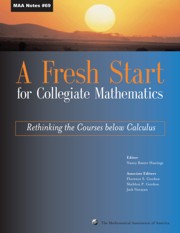Book contents
- Frontmatter
- Preface
- Contents
- Introduction
- Background
- Theme 1 New Visions for Introductory Collegiate Mathematics
- Theme 2 The Transition from High School to College
- Theme 3 The Needs of Other Disciplines
- Theme 4 Student Learning and Research
- Theme 5 Implementation
- Theme 6 Influencing the Mathematics Community
- Ideas and Projects that Work: Part 1
- Ideas and Projects that Work: Part 2
- 35 Mathematics in Action: Empowering Students with Introductory and Intermediate College Mathematics
- 36 Precalculus: Concepts in Context
- 37 Rethinking College Algebra
- 38 From The Bottom Up
- 39 The Functioning in the Real World Project
- 40 The Importance of a Story Line: Functions as Models of Change
- 41 Using a Guided-Inquiry Approach to Enhance Student Learning in Precalculus
- 42 Maricopa Mathematics
- 43 College Algebra/Quantitative Reasoning at the University of Massachusetts, Boston
- 44 Developmental Algebra: The First Mathematics Course for Many College Students
- 45 Workshop Precalculus: Functions, Data, and Models
- 46 Contemporary College Algebra
- 47 Precalculus: A Study of Functions and Their Applications,
- 48 Success and Failures of a Precalculus Reform Project
35 - Mathematics in Action: Empowering Students with Introductory and Intermediate College Mathematics
from Ideas and Projects that Work: Part 2
- Frontmatter
- Preface
- Contents
- Introduction
- Background
- Theme 1 New Visions for Introductory Collegiate Mathematics
- Theme 2 The Transition from High School to College
- Theme 3 The Needs of Other Disciplines
- Theme 4 Student Learning and Research
- Theme 5 Implementation
- Theme 6 Influencing the Mathematics Community
- Ideas and Projects that Work: Part 1
- Ideas and Projects that Work: Part 2
- 35 Mathematics in Action: Empowering Students with Introductory and Intermediate College Mathematics
- 36 Precalculus: Concepts in Context
- 37 Rethinking College Algebra
- 38 From The Bottom Up
- 39 The Functioning in the Real World Project
- 40 The Importance of a Story Line: Functions as Models of Change
- 41 Using a Guided-Inquiry Approach to Enhance Student Learning in Precalculus
- 42 Maricopa Mathematics
- 43 College Algebra/Quantitative Reasoning at the University of Massachusetts, Boston
- 44 Developmental Algebra: The First Mathematics Course for Many College Students
- 45 Workshop Precalculus: Functions, Data, and Models
- 46 Contemporary College Algebra
- 47 Precalculus: A Study of Functions and Their Applications,
- 48 Success and Failures of a Precalculus Reform Project
Summary
The Mathematics in Action project aims to empower college mathematics students with a real-world mathematical literacy that will provide a solid foundation for future study in mathematics and other disciplines. The project was developed by the Consortium for Foundation Mathematics, a team of fourteen SUNY and CUNY faculty, with support from the National Science Foundation (DUE 9455638), and is based on the AMATYC Crossroads Standards.
The project's goal to empower students mathematically focuses on developing desired student outcomes in five main areas: number sense, symbolic sense, a general function sense, a thorough linear function sense, and a sense of nonlinear relationships. The word “sense” in each of these areas certainly conveys developing requisite skills, but far more than that, it means generating mathematical intuition and building techniques of reasoning.
To achieve desired student outcomes, project materials are written with the expectation that by completing the course, students would be able to perform tasks beyond the basic skills/knowledge level. These tasks include extracting relevant data to solve realistic problems, analyzing and interpreting graphical and tabular data, recognizing and expressing, in verbal, numerical, graphical, and symbolical format, the patterns displayed by linear data, and identifying equivalent variable relationships in numerical, algebraic, and graphical format and translating those relationships from one representation to any of the others.
The project's objectives extend to developing general education competencies through its realistic contextual approach to learning mathematics.
- Type
- Chapter
- Information
- A Fresh Start for Collegiate MathematicsRethinking the Courses below Calculus, pp. 333 - 336Publisher: Mathematical Association of AmericaPrint publication year: 2006



